VICIOUS CIRCLE OF POVERTY
Poverty Alleviation Programmes in India
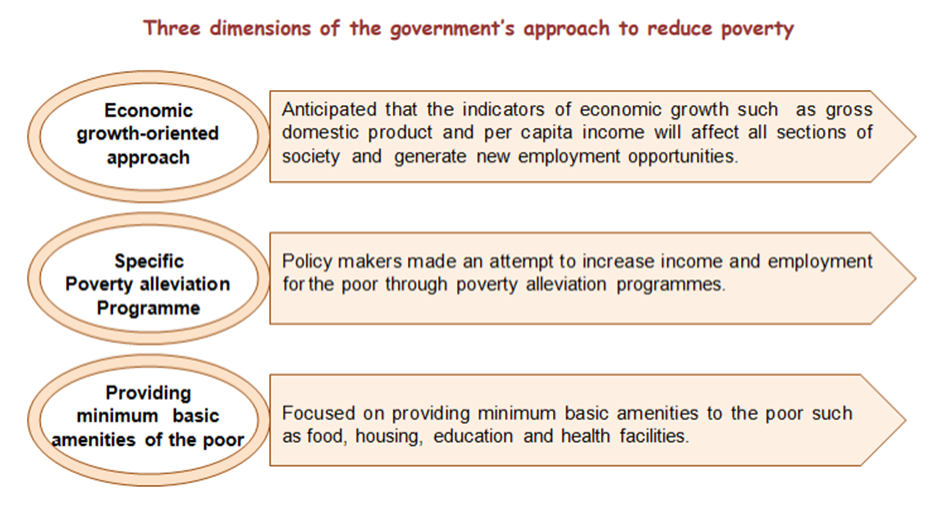
The government was not successful in poverty alleviation through the three-dimensional approach because of the following reasons:
- Although various initiatives were taken by the government to alleviate poverty, hunger and malnourishment, many regions of India lack basic amenities and educational facilities.
- The number of resources allocated for poverty alleviation programs was not sufficient to cope with the magnitude of poverty in India.
- Unequal distribution of income, corruption and mismanagement of poverty alleviation programs created obstacles in the process of removing poverty in India.
- Thus, government programs for employment generation, economic growth and poverty alleviation failed to alleviate poverty in India. In addition, government policies failed to tackle the majority of vulnerable groups.
Poverty Alleviation Programmes:
- Prime Minister Rozgar Yojana (PMRY)
- It provides financial assistance to set up any kind of enterprise.
- It generates employment opportunities for the educated unemployed from low-income families in rural and urban areas.
- Rural Employment Generation Programme (REGP)
- It is implemented through the Khadi and Village Industries Commission to assist eligible entrepreneurs to set up village industry units.
- It creates employment opportunities in villages including small towns with a population of up to 20,000.
- Mahatma Gandhi National Rural Employment Guarantee Act (MGNREGA)
- In this scheme, the state governments provide at least 100 days of guaranteed wage employment in every financial year to every household whose adult members volunteer to do unskilled manual work.
- If work is not provided within a 15-day period, then the applicant is eligible for unemployment allowance by the state government.
- Swarna Jayanti Gram Swarozgar Yojana (SJGSY)
- This was launched in 2000 to reduce the levels of poverty in India.
- The central government provided financial assistance to the states for the fulfillment of necessities such as primary health and education.
- It also aims to provide clean drinking water in rural areas and provide shelter to the poor.
Wage Employment Programmes
- Sampoorna Grameen Rozgar Yojana (SGRY): The scheme aims to provide additional and supplementary wage employment by undertaking labor-intensive work, thereby providing food security and increasing nutritional levels.
- Wages were paid as a combination of food grains and cash.
- The scheme of SGRY is open to all rural poor who need wage employment and desire to do manual and unskilled work in and around their village or habitat.
- National Food for Work Programme (NFFWP): This program was launched in 2004 with the objective of intensifying the generation of supplementary wage employment.
- NFFWP was initially implemented in 150 most backward districts of the country, to provide additional resources apart from the resources available under SGRY
- The program was implemented as a 100% Centrally Sponsored Scheme.
- Wage Employment under This program was incorporated in Mahatma Gandhi's "Food for Work" Programme National Rural Employment Guarantee Act (MGNREGA) in 2005.
- MGNREGA aims at enhancing the livelihood security of people in rural areas by guaranteeing 100 days of wage employment in a financial year to a rural household whose adult members volunteer to do unskilled manual work.
- All those among the poor who are ready to work at the minimum wage can report for work in areas, where this program is implemented.
- In 2013-14, nearly five crore households got employment opportunities under this law.
A critical assessment of poverty alleviation programs
- Due to unequal distribution of land and other assets, the benefits from alleviation programs have been appropriated by the non-poor.
- Compared to the magnitude of poverty, the amount of resources allocated for these programs are not sufficient.
- Resources are inefficiently used and wasted because the officials involved in the implementation of the program are ill-motivated, inadequately trained, corrupt and vulnerable to pressure from a variety of local elites.
- Government policies have also failed to address the vast majority of vulnerable people who are living on or just above the poverty line.
POVERTY
POVERTY
Meaning: Poverty refers to a state in which an individual is unable to fulfill even the necessities of life.
Poverty is the inability to secure minimum human needs such as food, clothing, housing, education and health. When a person is unable to fulfill these basic needs, it leads to pain and distress. The poor are people who reside in kutcha hutments with walls made of baked mud and roofs made of bamboo, grass and wood. They are illiterate with low skills and possess few assets for their day-to-day requirement. Based on the occupation and the ownership of assets, the poor can be identified in the rural and urban areas.
Common Characteristics of Poor People
- Hunger, starvation and malnutrition: Starvation and hunger are the basic problems of the poorest households. Malnutrition is alarmingly high among the poor.
- Poor Health: They are generally physically weak due to ill health, disability, or serious illness. Their children are less likely to survive or be born healthy.
- Limited Economic Opportunities: They have Bigger Families very limited economic opportunities due to a lack of literacy and skills. Therefore, they face unstable employment.
- Debt Trap: They borrow from moneylenders, who charge high rates of interest that push them into chronic indebtedness.
- Lack of facilities for electricity and water: Most poor households do not have access to electricity. Their primary cooking fuel is firewood and cow dung cake. A large section of poor people does not even have access to safe drinking water.
- Gender Inequality: Gender inequality prevails within the family in regard to the participation in gainful employment, education and in decision-making. Poor women receive less care on their way to motherhood.
- Bigger Families: The poor families are bigger in size, which makes their economic condition worse.
Causes of Poverty
- Inequality in the distribution of income and wealth
- During the plan periods, the national income of India has been increasing, but it has not been distributed properly among the different sections of people.
- Majority of the income of the economy has been enjoyed by the rich.
- These inequalities in the distribution of wealth and income have worsened the problem of poverty in India.
- Underdevelopment of an economy
- Physical and natural resources are underutilized because of a lack of technology, capital and entrepreneurial ability.
- Therefore, the productive capacity and gross domestic product of the economy are low.
- Primitive technology of production occurs in the agricultural sector.
- They lack irrigation facilities, fertilizers and a high-yielding variety of seeds.
- This backwardness in agriculture has given rise to rural poverty.
- Indebtedness
- Poor people take loans from the rich section of society to meet their basic needs.
- In return, they pay a high rate of interest for the amount borrowed from moneylenders.
- Moneylenders exploit them, and they thus live below the poverty line from one generation to another.
- Price inflation
- Upward trends in the consumer price index during the plan periods led to a fall in the real income of fixed and low-income earners.
- Inflation decreases the purchasing power, and hence, there is a low standard of living and a high incidence of poverty.
- High rate of population growth
- Because of an increase in population, the dependency burden has increased.
- Hence, the provision for their minimum needs becomes a crucial problem.
- This high growth rate of the population also signifies lower availability of health facilities and other amenities and therefore a lower standard of living.
- Unemployment
- The poverty level increases with the rise in the number of unemployed.
- Because of unemployment, the number of dependents on the employed population increases.
- This results in a decline in the consumption expenditure per head and a majority of people are living in poverty.
- Illiteracy
- Because of a lack of literacy, Indian farmers fail to learn new methods of cultivation or adopt new tools for production.
- In addition, village moneylenders succeed in cheating them more easily.
- On the other hand, urban people are employed as unskilled workers and receive very low wages in return.
- They mostly live in slums and lead miserable lives.
- Social causes
- Many social factors such as the caste system, religious faith and beliefs, and joint family system have hindered the process of economic growth.
- Political causes
- Policies of the colonial government have ruined traditional handicrafts and discouraged the development of textile industries.
- Even after Independence, the government failed to protect the interests of the poor.
Global Hunger Index
The Global Hunger Index aims to track hunger at the world, regional and country levels. It is an annual report (peer-reviewed) published by Concern Worldwide of Ireland and Welthungerhilfe (a German non-profit organization).
Global Hunger Index Scoring
GHI ranks countries on a 100 point scale, with 0 representing zero/no hunger. The GHI scores are based on four indicators. Taken together, the component indicators reflect deficiencies in calories as well as in micronutrients. Thus, the GHI reflects both aspects of hunger (undernutrition and malnutrition).
- UNDERNOURISHMENT: the share of the population whose caloric intake is insufficient.
- CHILD STUNTING the share of children under the age of five who have low height for their age.
- CHILD WASTING is the share of children under the age of five who have low weight for their height.
- CHILD MORTALITY: the mortality rate of children under the age of five (a reflection of the fatal mix of inadequate nutrition and unhealthy environments).

India ranks 101st out of 116 countries in the GHI 2021 rankings. With a score of 27.5, India has a level of hunger that is ‘serious’.
TYPES OF POVERTY
Types of Poverty
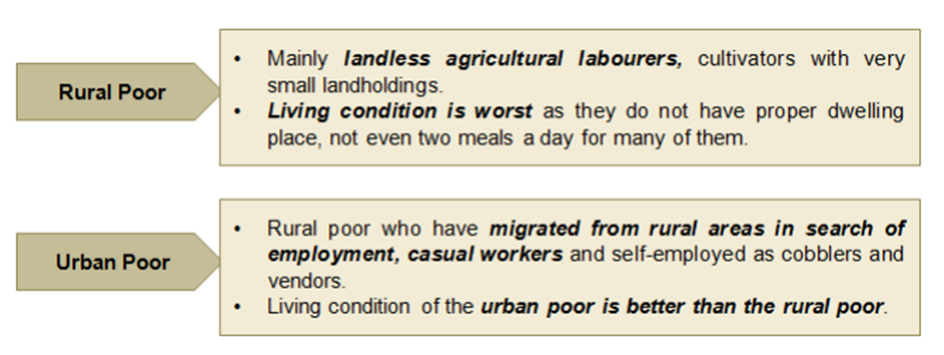
Poor in Urban and Rural Areas:
- In Urban Areas, poor people include pushcart vendors, street cobblers, rag pickers, beggars, etc.
- They possess few assets.
- They reside in kutcha hutments with walls made of baked mud and roofs made of grass, thatch, bamboo and wood.
- The poorest of them do not even have such dwellings.
- The urban poor is largely the overflow of the rural poor who had migrated to urban areas in search of alternative employment and livelihood.
- In Rural Areas, poor people include landless agricultural labourers, cultivators with very small landholdings, landless labourers engaged in a variety of non-agricultural jobs or tenant cultivators with small land holdings.
- Many of the rural people are landless. Even if some of them possess land, it is only dry or wasteland.
- Many rural people do not get to have even two meals a day.
MEASURES OF POVERTY
There are two measures to determine the extent of poverty:
- Relative Poverty
- Absolute Poverty
Relative poverty refers to poverty of people, in comparison to other people, regions or nations. For example, If Ram has a lower income in comparison to Sham, and then we can say that Ram is relatively poor. It helps in understanding the relative position of different segments of the population. It only reflects the relative position of different segments of the population in the income hierarchy. It does not consider, how poor the person is or whether he is deprived of the basic minimum requirements of life or not.
Absolute Poverty refers to the total number of people living below poverty line. According to absolute measures, around 22% of India's population is below the poverty line. The concept of absolute poverty is relevant for the less developed countries like India, where there is abundance of poverty. It helps to measure the number of poor people. The method of "Poverty Line" used to measure absolute poverty does differentiate between the very poor and the other poor. Moreover, it does not consider social factors that generate and are responsible for poverty, illiteracy, ill-health, lack of access to resources, discrimination, or lack of civil and political freedoms.
Measurement of Poverty: Pre and Post Independent India
- In the Pre-independent India, DadabhaiNaoroji was the first person to discuss the concept of Poverty Line. He used the 'Jail Cost of Living' to calculate the poverty line.
- He used the menu for a prisoner and used appropriate prevailing prices, to arrive at the cost of consumption of an adult prisoner.
- He termed this consumption cost as 'jail cost of living'. As only adults stay in jail, he divided the population into two parts:
- He assumed that one-third of total population consist of children. One-half of them (i.e. 1/2 of 1/3 - 1/6) consumed very little, while the other half (i.e. 1/2 of 1/3 = 1/6 consumed half of the adult diet.
- Two-third population consisted of adults and they consume full diet.
- Weighted Average of consumption of the three segments: The average poverty line comes out to be three-fourth of the adult jail cost of living.
- 1/6 x Nil Diet + 1/6 x Half-Diet + 2/3 x Full Diet = 1/6 x 0+ 1/6 x 1/2 + 2/3 x 1= ¾.
POVERTY LINE
CONCEPT OF POVERTY LINE
Meaning: The poverty Line is a cut-off point on the line of distribution, which usually divides the population of the country into poor and non-poor.
- The concept of the poverty line is used to measure the extent of poverty in a country.
- People having income below the poverty line are called "Poor; and.
- People with income above the poverty line are called "Non-Poor".
- Poverty line tries to capture the socially acceptable minimum living standards, which the society tries to fulfill.

Determination of Poverty Line in India
- In India, the "Monthly Per Capita Expenditure or MPCE" method is used to determine the poverty line. According to this method, the monetary value (per capita expenditure) of the minimum calorie intake is calculated.
- Minimum Calorie Intake: The Planning Commission has defined the poverty line based on recommended nutritional requirements of 2400 calories per person per day for rural areas and 2100 calories per person per day in urban areas. Higher calorie intake has been fixed for rural areas because the rural worker has to do greater physical work as compared to the urban worker.
- The monetary value of minimum calorie intake: According to the Planning Commission (Tendulkar Methodology), the minimum Monthly Per Capita Consumption Expenditure (MPCE) in 2011-12 is worked out to be 816 per person in rural areas and 1,000 in urban areas.
- Poverty Line Divides the Poor from the Non-Poor: There are many kinds of poor; the poor, the very poor and the poor. Similarly, there are various kinds of non-poor: the middle class, the upper-middle class, the rich, the very rich and the absolutely rich. The poverty line divides the poor from the non-poor.
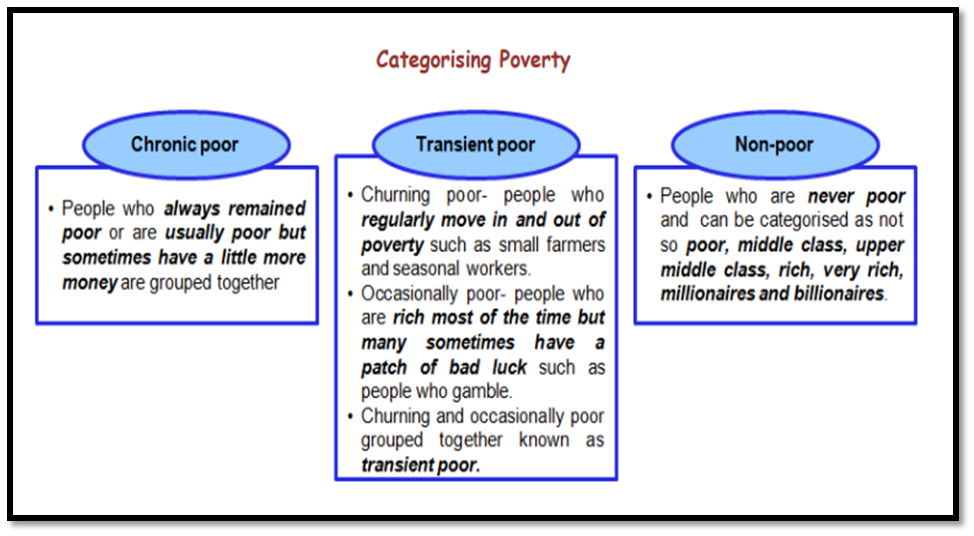
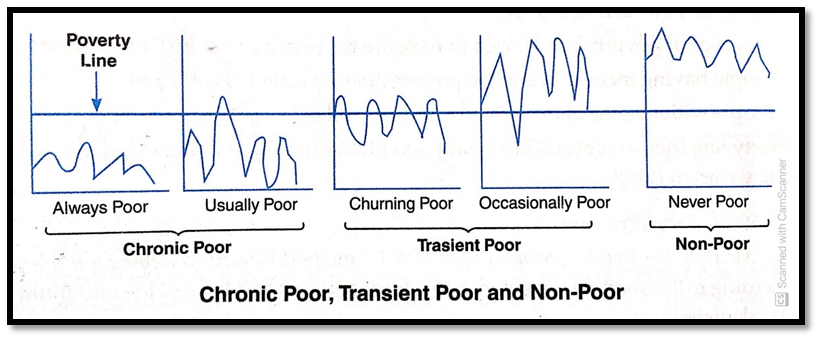
GLOBAL MULTIDIMENSIONAL POVERTY INDEX
Global Multi-Dimensional Poverty Index
- The Global MPI stands for Multidimensional Poverty Index which is released by Oxford Poverty and Human Development Initiative (OPHI).
- The idea behind this index is to measure acute multidimensional poverty across developing countries using various indicators.
- It was developed by OPHI with the United Nations Development Programme (UNDP) in 2010. It is a part of UNDP’s Human Development Report (HDR) and is released annually.
- MPI 2021 was released in September 2021.
- India ranked 62 in the Global MPI 2020, which ranked 107 countries. The MPI 2022 is to be released in July, which is the month the index is released every year.
Brief Facts about the Multidimensional Poverty Index (MPI)
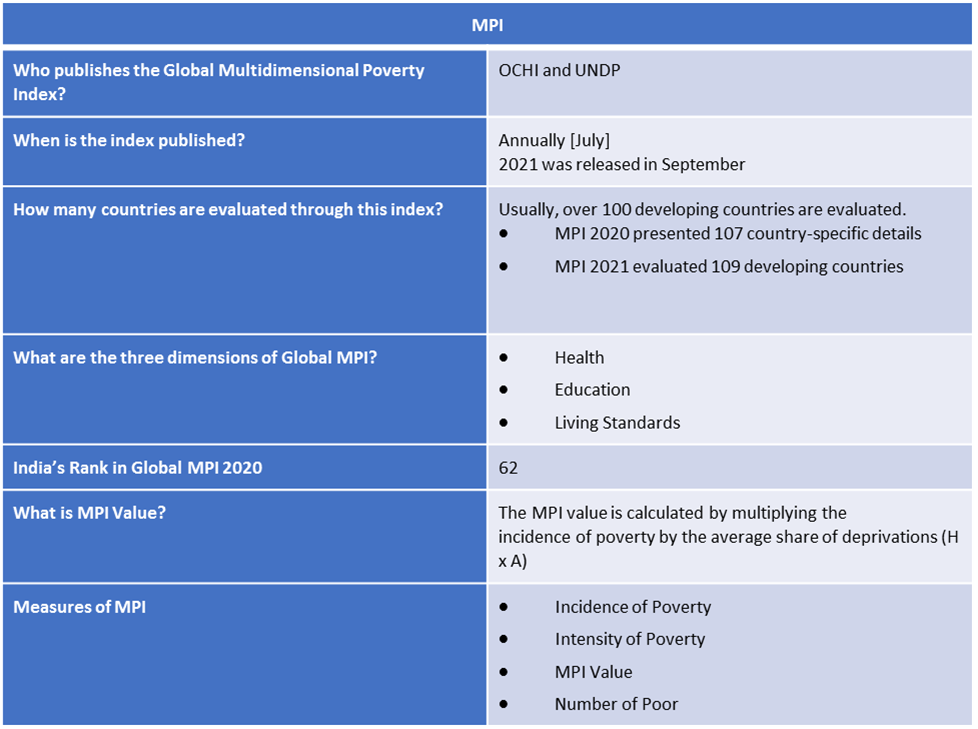
Dimensions and Indicators of Global MPI
There are three dimensions and 10 indicators using which countries’ performances are measured.
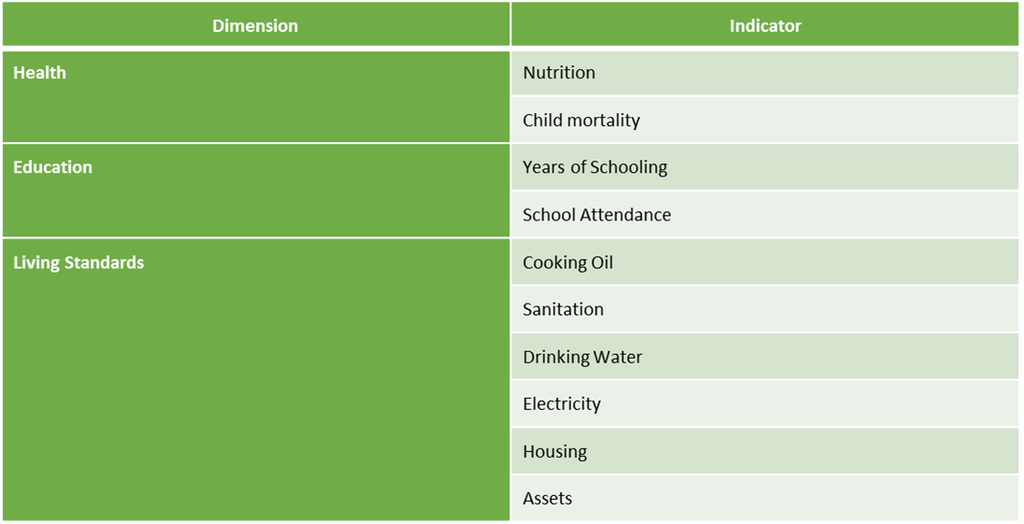
URBAN v/s RURAL POVERTY
The number of poor in India.
When the number of poor is estimated as the proportion of people below the poverty line, it is known as the 'Head Count Ratio'. In other words, Head count ratio is calculated by dividing the number of people below the poverty line by the total population.
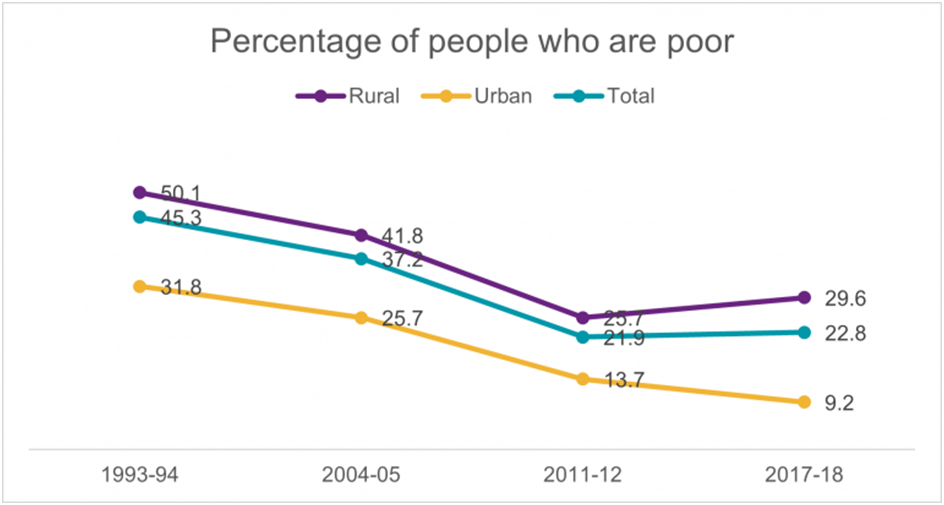
Number and Proportion of People Below Poverty Line:
- Number of People Below Poverty Line: In 1973-74, more than 320 million people were below the poverty line. In 2011-12, this number has come down to about 270 million.
- The proportion of People Below Poverty Line: In terms of proportion, in 1973-74, about 55% of the total population was below the poverty line. In 2011-12, it has fallen to 22%
- From 1973-74 to 2011-12, there has been a considerable decline in the number of poor and their proportion, but the nature of the decline in the two parameters is not encouraging. The rate is declining much slower than the absolute number of poor in the country.
The extent of Urban-Rural Poverty
- In 1973-74, more than 80% of the poor reside in rural areas and this situation has not changed even in 2011-12. It means, of the poor in India still reside in villages. In addition, poverty, which was prevailing predominantly in rural areas, has shifted to urban areas.
- In the 1990s, the absolute number of poor in rural areas had declined, whereas the number of their urban counterparts increased marginally. The poverty ratio declined continuously for both urban and rural areas.
- The gap between the absolute number of poor in rural and urban areas got reduced, where in the case of ratio, the gap has remained the same until 1999-2000 and has widened from 2011-12
State-Level Trends in Poverty
- Five states (Uttar Pradesh, Bihar, Madhya Pradesh, West Bengal and Odisha) account for about 70% of India's poor. During 1973-74, about of the population in most of these large states was living below the poverty line.
- The diagram reveals that six states (Tamil Nadu, Uttar Pradesh, Bihar, Madhya Pradesh, West Bengal and Orissa) contained a large section of the poor in 1973-74.
- During 1973-to 2012, many Indian states (like West Bengal and Tamil Nadu) reduced the poverty levels to a considerable extent.
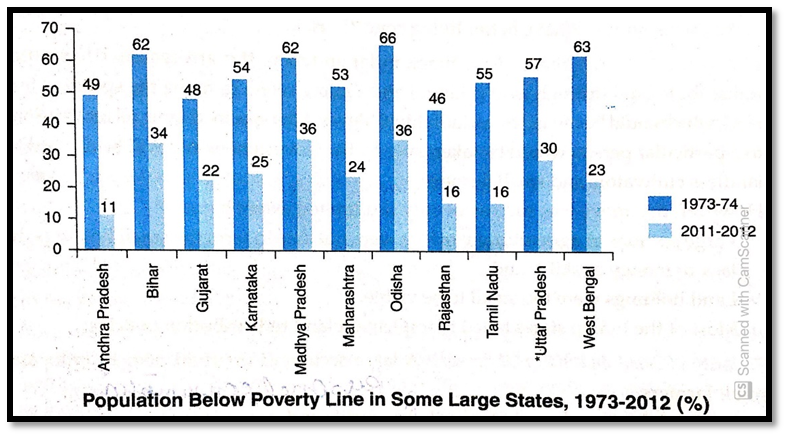
POVERTY & AGRICULTURE SECTOR
British Rule: Adverse Effect on Living Standard of Indians
1. British Government systematically destroyed Indian industries. Their primary motive behind the de-industrialization was two-fold:
- To get raw materials (like cotton, jute, etc.) from India at cheap rates to be used by upcoming modern industries in Britain.
- To sell finished products (like cotton cloth) of British industries in the Indian market at higher prices.
2. More than 70% of Indians were engaged in agriculture throughout the British Raj period. British policies raised rural taxes, which enabled merchants and moneylenders to become large landowners.
3. Under British rule, India began to export food grains. It was responsible for frequent famines and as many as 26 million people died in famines between 1875 and 1900.
4. In short, the British Raj made the miserable conditions for people in India. Their main goal was to provide a market for British exports, to have India service its debt payments to Britain, and for India to provide labor for the British imperial armies.
Agriculture: Still the Principal Means of Livelihood
- Low success rate of Land Ceiling: Since independence, the government has opted to redistribute land through the land ceiling. Land Ceiling refers to fixing the specified limited land, which could be owned by an individual. Beyond the specified limit, all lands belonging to a particular person would be taken over by the Government and will be allotted to landless cultivators and small farmers. However, this move was successful only to a limited extent because
- Large sections of agricultural workers were not able to farm the smallholdings dues lack of money or skills, and
- Landholdings were too small to be viable.
- Most of the Indian states failed to implement land redistribution policies.
- Majority of small and marginal farmers: A large section of the rural poor in India is the small farmers. personal consumption.
- The land that they have is generally less fertile and dependent on rains.
- Their survival depends on subsistence crops like wheat and sometimes on livestock Subsistence agriculture is self-sufficiency farming in which the farmers focus on growing enough food to feed themselves and their families.
- Fragmentation of land holdings: With the rapid growth of population and without alternative sources of employment, the per-head availability of land for cultivation has steadily declined
- It has led to fragmentation of land holdings.
- The income from these small land holdings is not sufficient to meet the family's bus requirements. It has led to distress among the farmers.

 PathSet Publications
PathSet Publications
